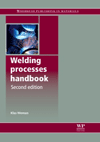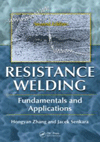Both MIG and TIG welding are well-suited for a wide range of assembly applications in manufacturing.
Both MIG and TIG welding are widely used in manufacturing, both manually and in automated and semiautomated systems. The American Welding Society (AWS) formal terminology for MIG-the acronym means metal inert gas-welding is gas metal arc welding (GMAW). Similarly, the AWS formal terminology for TIG-the acronym means tungsten inert gas-welding is gas tungsten arc welding (GTAW). Both are universally recognized, but they remain commonly referred to as MIG and TIG welding. To many old-time welders, however, TIG is still Heliarc, the Linde trademark by which the process was known for years.
MIG welding uses a consumable wire electrode fed continuously into the molten weld pool to provide the filler needed in a welded joint. A constant flow of inert gas is fed through the welding gun with the filler wire to shield the molten weld pool from the surrounding air, preventing oxidation of the weld.
MIG welding was originally developed for welding aluminum and other nonferrous metals using argon as the shielding gas. The relatively high cost of argon precluded wider application on steel parts until the use of semi-inert gases such as CO2became common. Further developments improved versatility. Today, MIG welding is the most common industrial welding process because of speed and adaptability.
MIG welding produces long, continuous and consistent welds, which is especially advantageous in welding automotive frames. It also produces very clean welds with no slag and very little spatter. It is particularly well-suited for robotic welding, which is one of the reasons it is used extensively in the automotive industry. It is also widely used in the sheet-metal industry.
Any finished weld should have mechanical properties similar to those of the base metal, so the choice of electrode is a key factor in weld quality. A wide variety of electrode wire is available for welding both ferrous and nonferrous metals. All commercially available electrodes contain small amounts of deoxidizing metals to help prevent oxygen porosity, and some contain denitriding metals to avoid nitrogen porosity.
The shielding gas keeps oxygen and nitrogen-which can cause fusion defects, porosity and embrittlement-away from the weld pool, so the choice of shielding gas is also a key factor in weld quality. Pure argon or helium are only used with nonferrous metals. For welding steel, penetration is inadequate with argon and spatter is excessive with helium. Pure CO2allows deep penetration but encourages spatter and oxide formation. Hence, mixtures of argon and CO2in various percentages are commonly used for welding steel.
TIG welding, by contrast, uses a nonconsumable tungsten electrode and filler metal-if needed-is fed either manually or automatically, but not through the welding gun. As in MIG welding, a constant flow of inert gas, typically a mixture of argon and helium, is fed through the welding gun to shield the molten weld pool from the surrounding air, preventing oxidation of the weld.
TIG welding was originally developed for welding aluminum and magnesium alloys. Today it is used for welding nonferrous metals, stainless steel, and carbon and low-alloy steel. The greatest advantage of TIG welding is that it will weld more kinds of metals and alloys than any other arc welding process. It is a clean process that produces welds with no slag, no sparks and no spatter. Its main disadvantage is the low deposition rate of filler metal. Also, the necessary hand-eye coordination is difficult to learn and requires a great deal of practice to become proficient.
TIG welding is used extensively in the aerospace industry as well as many others. It is widely used for joining thin parts and it is ideal for welding small diameter thin-wall tubing, such as is used in the bicycle industry. Some TIG welds, especially in small stainless steel parts, are simple fusion, or autogenous welds, meaning no filler metal is added to the molten pool and the two parts are simply fused together.
Filler metal is not lost by volatilization in the arc as in some other processes, so TIG welds have the same chemical integrity as the base metals, presuming the correct choice of filler metal. Consequently, TIG welds are highly resistant to corrosion and cracking, making it ideal for critical applications like sealing spent nuclear fuel canisters before burial.
Get our new eMagazine delivered to your inbox every month.
Stay in the know on the latest assembly trends.
SUBSCRIBE TODAY!Copyright ©2024. All Rights Reserved BNP Media.
Design, CMS, Hosting & Web Development :: ePublishing


